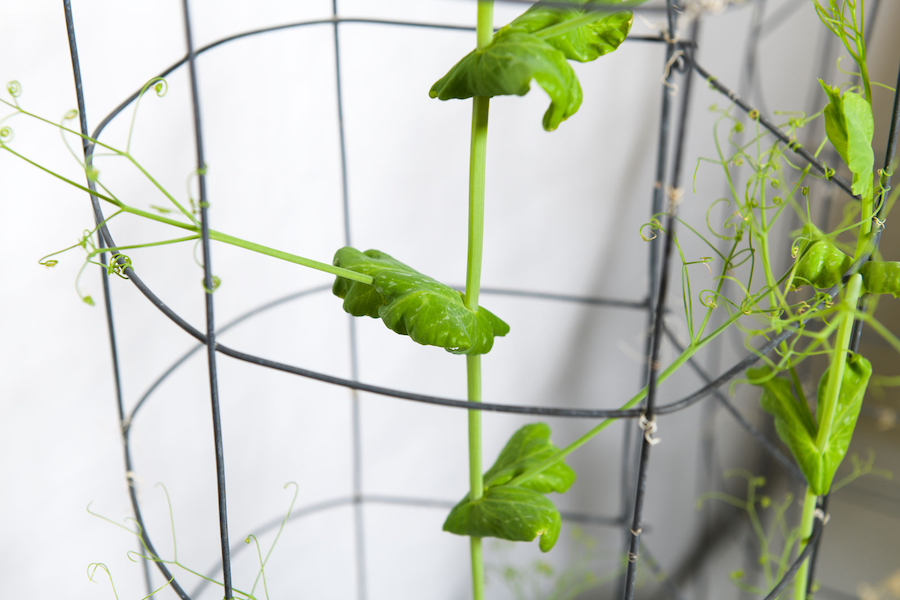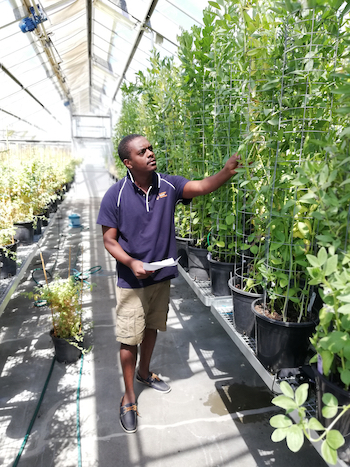Improving and developing new pulse varieties is dependent on seed imported from around the world. The seed, however, has the potential to carry an invisible payload of disease-causing microorganisms, particularly viruses.
This danger is mitigated through post-entry quarantine protocols that include antibody tests for individual pathogens of concern. With the advent of genome sequencing technology, however, new robust testing and diagnostic capabilities are being rolled out around the world.
To explore the potential of this emerging capability, GRDC has invested in technological development for use in the post-entry quarantine of pulse seed at the Australian Grains Genebank (AGG).
That investment got under way in 2016 and succeeded in developing diagnostic tools for both harmful and beneficial microorganisms based on the most advanced high-throughput sequencing (HTS) technology.
The innovative research (PulseBio 4) was led by Dr Solomon Maina under the leadership of Professor Brendan Rodoni and was undertaken within a strategic partnership between Agriculture Victoria and GRDC. The work was performed at the Grains Innovation Park in Horsham, Victoria, where the AGG is located.
Dr Maina says safeguarding AGG pulse seed collection against known viruses was the primary focus, but adds the diagnostic technology was also applied to screen and catalogue novel beneficial microorganisms in imported seed. These beneficial microbes have the potential to boost pulse crop productivity through a variety of agronomic impacts, including improved nitrogen fixation rates.
“We developed targeted genome tests that are highly sensitive and cost-effective. The technology can be applied stands to expedite both endemic and exotic crop virus surveillance and the cataloguing of novel beneficial microorganisms for use in breeding programs,” he says.
The ability to readily share this genomic data was also streamlined as part of this project to help ensure easy access by Australian pulse breeders.
The pathogens

Field pea infected with pea seed-borne mosaic virus (PSbMV). Photo: Agriculture Victoria
The Australian Government requires the destruction of cereal and pulse plant material that tests positive for viruses considered a threat to the Australian grains industry. Specific antibodies are required to test for many pathogenic viruses of concern.
In contrast, the new sequencing tools can concurrently detect multiple viruses per test without the need for developing specific antibodies. The current test detects four at once and the testing number is likely to double in the near future.
The test uses PCR (polymerase chain reaction) technology to amplify telltale segments of the four virus genomes. These fragments are then rapidly and cost-effectively sequenced to complete the identification.
However, the technology is highly dependent on the availability of genome sequence data for the viruses of concern. Prior to this project, only a handful of viral genomes of biosecurity concern to Australia were publicly available.
Throughout the project, Dr Maina generated numerous full genome sequences to aid in diagnostic development for both exotic and endemic virus threats. He drew on extensive sequencing expertise gained working with both crop and animal microbial genome sequencing at the Nairobi arm of the International Livestock Research Institute (IRLI).
Virus-infected field peas, lentils, chickpeas and faba beans were sequenced and full genome assemblies were then generated, providing the foundation for new PCR-based diagnostics to be performed at the post-entry quarantine facility at Horsham. The following viruses were sequenced:
- Broad bean wilt virus-2 (BBWV-2);
- broad bean true mottle virus (BBTMV);
- broad bean mottle virus (BBMV);
- broad bean stain virus (BBSV);
- pea early browning virus (PEBV);
- cucumber mosaic virus (CMV); and
- pea seed-borne mosaic virus (PSbMV).
Benefits to industry are highlighted by the analysis of PSbMV genomes that confirmed the lentil strains that are damaging crops overseas are absent in Australia. This is a significant finding for growers, as keeping the PSbMV lentil strain out of Australia will require stringent quarantine procedures and highlights the importance of virus genome surveillance measures to protect the lentil industry.
“The diagnostic tests will be included as standard operating procedures in the AGG post-entry quarantine facility and used to confirm virus interceptions detected at the border,” Dr Maina says.
The beneficials
 Besides better diagnostics for virus threats, Dr Solomon Maina is also helping to make better use of beneficial microorganisms that have far-reaching implications for pulse crop productivity. Photo: Agriculture Victoria
Besides better diagnostics for virus threats, Dr Solomon Maina is also helping to make better use of beneficial microorganisms that have far-reaching implications for pulse crop productivity. Photo: Agriculture Victoria
A capability has also been established to identify beneficial bacterial and fungal species that reside in the microbiome in plant material within AGG’s post-entry quarantine.
For example, sequencing of a field pea line revealed the presence of biologically important bacteria, including from the Burkholderia genus that is known to promote plant growth and nitrogen fixation.
Analysis of lentil material revealed an abundance of fungal genera, including Alternaria reported to produce biologically active compounds and mycoherbicides that are useful for weed control. Previous studies also found that when these microbes work closely with a consortium of other beneficial microbes, added benefits include induced systemic disease defence, growth promotion and enhanced drought stress tolerance in crops.
“Traditionally, breeding programs have primarily focused on exploring the crop’s genetic diversity to improve crop productivity and stress resistance,” Dr Maina says. “However, the work undertaken in this project opens up possibilities to systematically explore and exploit interactions between beneficial microbes and plants, with concurrent gains in on-farm profitability and sustainability.”
The ability to access and exploit the relevant genome sequencing data has been optimised following consultation with the AGG curator, Dr Sally Norton, and AGG database manager Zakir Hossain.
As a result, AGG pulse germplasm is now equipped listed with its own extensive profile of viral, bacterial and fungal sequences detected during screening at the post-entry quarantine facility.
“Breeders and researchers can now link to the AGG database through the GRIN-Global database platform that greatly facilitates accessing and using genomic data,” Dr Maina says. “The information is expected to help breeders make informed decisions, for example, by providing the ability to select germplasm with the highest beneficial microbiome abundance to include in a breeding program.”
He adds that continued investment in genome-based diagnostics is needed to maintain stringent biosecurity measures at the border and deliver passport data for germplasm entering Australia that can substantially enhance the development of more productive and resilient crops.
More information: Solomon Maina, solomon.maina@agriculture.vic.gov.au

























































